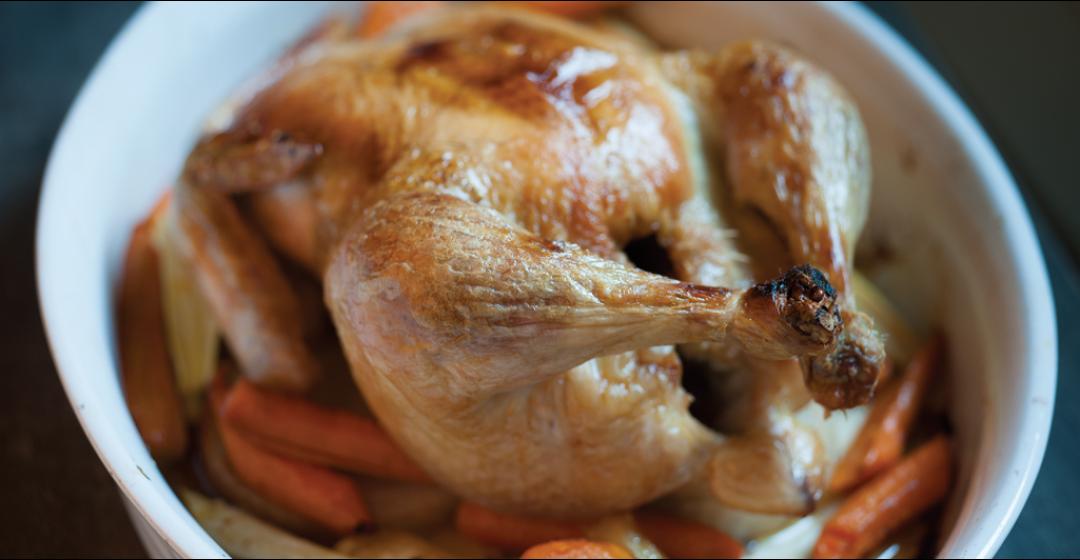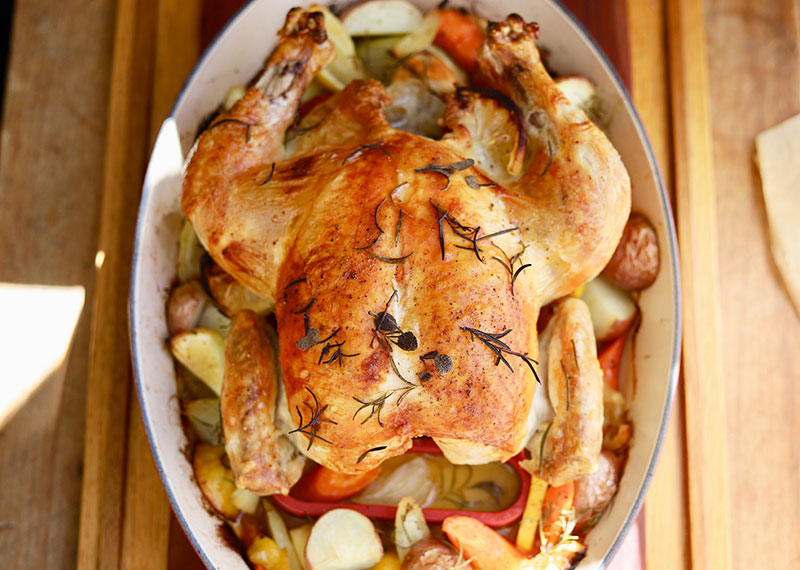My aunt Ellen Blue loves to cook. She favors simple dishes, and we often discuss and exchange recipes. So when Aunt Ellen, now in her eighties, visited last summer, I was shocked to learn she had never roasted a chicken, one of the simplest meals I can think of.
Nothing could be easier, I told her. Season a whole bird with a little salt and pepper, and place it in the oven. After an hour or so, mouth-watering aromas fill the house, and fifteen to twenty minutes later, dinner is ready to serve.
Admittedly, while roasting a chicken is easy, getting tender, juicy, evenly cooked white and dark meat with a crispy golden skin can be a challenge. Even experts can’t agree on the best methods. I explored a few respected recipe sources, including the magazines Cook’s Illustrated and Fine Cooking, and cookbook authors Ina Garten and Molly Stevens. I also tried online recipes such as Perfect Roast Chicken and Best Ever Roast Chicken.
Recommendations vary widely. Oven temperatures range from a moderate 375 all the way up to 450 degrees. Some have you brine the bird, or claim butter under the skin ensures moister white meat; others fill the cavity with fresh herbs and lemon halves; some place the chicken breast-down first or turn the bird from side to side. You get the picture.
Though I had hoped one method would stand out, a sentence I read in Molly Stevens’s All About Roasting cookbook rang true. After she had roasted chicken exhaustively, she wrote: “In the end, I can now honestly say that with few exceptions, every method turned out a tasty roast chicken. What I discovered ultimately is that there is no single ‘best’ way to roast a chicken. Instead, there are different ways, each with its own benefits.”
I found, after roasting chickens for three weeks, certain important elements became clear.
Taste starts with the bird itself
For taste and texture, Island-raised chicken and Bell & Evans (a brand available at Cronig’s Markets in Vineyard Haven and West Tisbury and at Edgartown’s Shiretown Meats) have more flavor than supermarket counterparts from Tyson or Perdue.
A recent issue of Cook’s Illustrated magazine explained why some brands can taste better than others, as it tested twenty-one supermarket brands and recommended Bell & Evans as the tastiest. The testers learned that most chicken brands are water-chilled (often in chlorinated water for killing bacteria), and the meat absorbs water, which can dilute the real chicken flavor. Some brands, including Bell & Evans, use the European method of air chilling, in which chickens hang in a cold room instead of soaking.
Most supermarket chickens today are industrially raised: The birds are crammed together in windowless buildings, and they receive hormones and antibiotics, Benadryl, Tylenol, and Prozac, even yellow dye – all of which affect the end product. Locally raised chickens have a huge head start in this aspect.
“They’re outside running around in the sunshine and the wind,” explains Richard Andre, owner of West Tisbury’s Cleveland Farm, which is responsible for approximately one-third of the ten thousand chickens raised on the Island this year. “They’re moving every day. It’s outside and natural, where animals should live. All of that stuff makes the product that much better. It’s common sense when you think about it.”
Richard, who also raises turkeys, cooperates with other chicken farms on-Island, such as Edgartown’s FARM Institute and the Good Farm in Vineyard Haven. He’s actively lobbying for a Vineyard slaughterhouse. “What you notice in a lot of super-market chickens, there’s no flavor,” he says, adding that the taste of Island chicken often sells itself despite the higher price per pound. “Our hardest sale is always the first one,” he says.
Salt is key
Seasoning a chicken is important, and salt is one of the simplest ways to bring out the flavor. I explored other options: I tried roasting chickens stuffed with herbs such as thyme and rosemary, smearing herb-studded butter over and under the skin, and massaging them with dried spices and herbs. I loved that idea, but the flavors never really seemed to penetrate the meat.
The most flavorful chickens turned out to be the ones where salt penetrates the meat. One method is to brine a chicken before roasting – placing the bird in a bowl of water seasoned with salt for an hour. The salt breaks down tough muscle fibers so they don’t tighten up so much during cooking. And the salty water bonds to the protein of the chicken for a juicier, more flavorful meat. The reference book The Science of Good Food explains that meat can lose nearly 20 percent of its moisture during the cooking process; brining can cut that moisture loss nearly in half.
Cook’s Illustrated is a big proponent of brining chickens. I tried its Simple Roasted Chicken, and it was the best of the three chickens I roasted that day, juicy and flavorful with crisp, browned skin. But I was happy to discover an easier salting technique in All About Roasting: For a four-pound chicken, rub two to three teaspoons of salt over the entire bird and inside the cavity the day before roasting (you can also add pepper, spices, and/or herbs) and let the pre-salted bird sit in the refrigerator uncovered for twenty-four to thirty-six hours.
“The one constant I found, in all my testing, is the huge benefit of pre-salting chicken a day ahead of roasting,” Stevens writes. “I can’t stress enough how much this simple step improves the flavor and texture of the bird.”
I had read that for turkeys, exposing the skin overnight draws out moisture from the skin, helping it crisp up as it cooks. My pre-salted chicken had crispy skin and tender, flavorful breast meat. This method requires some advance work, but it’s easier than brining.
Tips for cooking
Before roasting, let the chicken sit at room temperature about thirty minutes. If you don’t have a roasting rack, improvise by placing thickly sliced onions or lemon slices under the chicken to lift it off the roasting pan. This allows heat to circulate under the chicken and promotes even cooking.
There’s no need to truss or baste. Trussing makes for a tidy-looking bird but may prevent dark meat from cooking evenly by having the legs tied closely against the breast meat. Basting doesn’t necessarily make the chicken juicier or tastier, and it lessens the skin’s crispiness. Opening the oven door lowers the heat and prolongs cooking time too.
An instant-read thermometer is very helpful in determining when the chicken is done, before the white meat is overcooked. Early in testing, my instant-read thermometer was broken and I relied on instructions such as “when the juices run clear” or “when the drumstick is somewhat loose at the joint.” They’re not always easy to figure out.
When I bought a new thermometer, the chickens tasted better. I was pulling them out at just the right time, when the thermometer, inserted in the thigh, read 165 to 170 degrees. My favorite thermometer is Thermapen from ThermoWorks, though it’s a bit pricey – about $80. Another good (and less expensive) thermometer is the CDN Proaccurate Quick Tip Cooking Thermometer, about $20.
After roasting, let the bird rest outside the oven for ten to fifteen minutes to allow the juices to recirculate in the meat. If you cut too soon, the juices will run out onto your cutting board and the meat will be less moist.
Three weeks and fourteen chickens later, armed with a new set of techniques, my own roast chicken has improved. But for the real test, I sent the recipes to Aunt Ellen. I’m happy to report her first roast chicken ever was a success.
“The dinner I just had was sumptuous,” she wrote in an e-mail. “I think the salting and leaving it open in the refrigerator all night is what made it so juicy [and] tender.
“It was so easy, I couldn’t believe it,” she added. “I truly mean it when I say it was the best-tasting chicken ever.”
Chicken and sauce recipes
Simple Roast Chicken with Pan Gravy or Lemon-Herb Sauce
Roast Chicken with Pan-Roasted Vegetables








